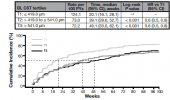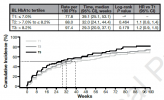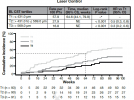So I've had three Eylea shots now, which my ophtho regards as the initial loading dose. It's just into week 9 of the treatment; review at week 12 to plot the next stage.
According to the ophtho's Cirrus OCT device, my problem eye's CST thickness has gone from about 400 microns to about 350 over the 8 weeks, which he says is good progress. He wants to see it down at 300, which makes sense, given that the diagnostic threshold with the Cirrus is 305 microns, for men.
Wondering how many more eyebll shots I'm likely to need, I found this fresh study examinging exactly that question:
https://www.ophthalmologyretina.org/article/S2468-6530(22)00341-4/fulltext
(Aflibercept = Eylea)
Amongst other things, looking at probability of full resolution in terms of CST thickness & time to achieve it.
The CST values aren't completely apples-vs-apples because the study is based on patient records which mostly didn't record the type of device, and CST measures vary between devices. So for "resolution" they set the threshold at 290 microns, which is the low end of the thresholds for the common devices, equal to the female level for the Cirrus. This might have some marginal effect but not worth worrying about.
One of the findings is that time to resolution on average partially depends on baseline CST thickness, I suppose not really surprising. My ~400 micron starting point is in their "least thick" tier T1, for which the median time to resolution is about 20 weeks, say 5 shots worth; and the probability of full resolution is about 80%.
View attachment 21946
Anyway, useful for me in terms of giving some shape to expectations and maybe others might find the same.
Maybe surprisingly, HbA1c doesn't seem to be a factor in CST thickness resolution:
View attachment 21947
The lowest HbA1c tier had the longest time to 50% resolution etc, but I don't think the results are statistically significant.
Should add that Aylea and its competitors seem like pretty amazing treatments. Despite being EYEBALL INJECTIONS they're not very invasive - 5 minutes in the eyeyball injection chair & then off you go, all completely normal except maybe for a few floaters. And evidently they are really effective.
Compare this to the nasty invasive, damaging and less effective old laser treatments ...
View attachment 21948
(Study was funded by Regeneron, the maker of Eylea, and they were involved in execution, but I don't think that's a big deal for these purposes.)



